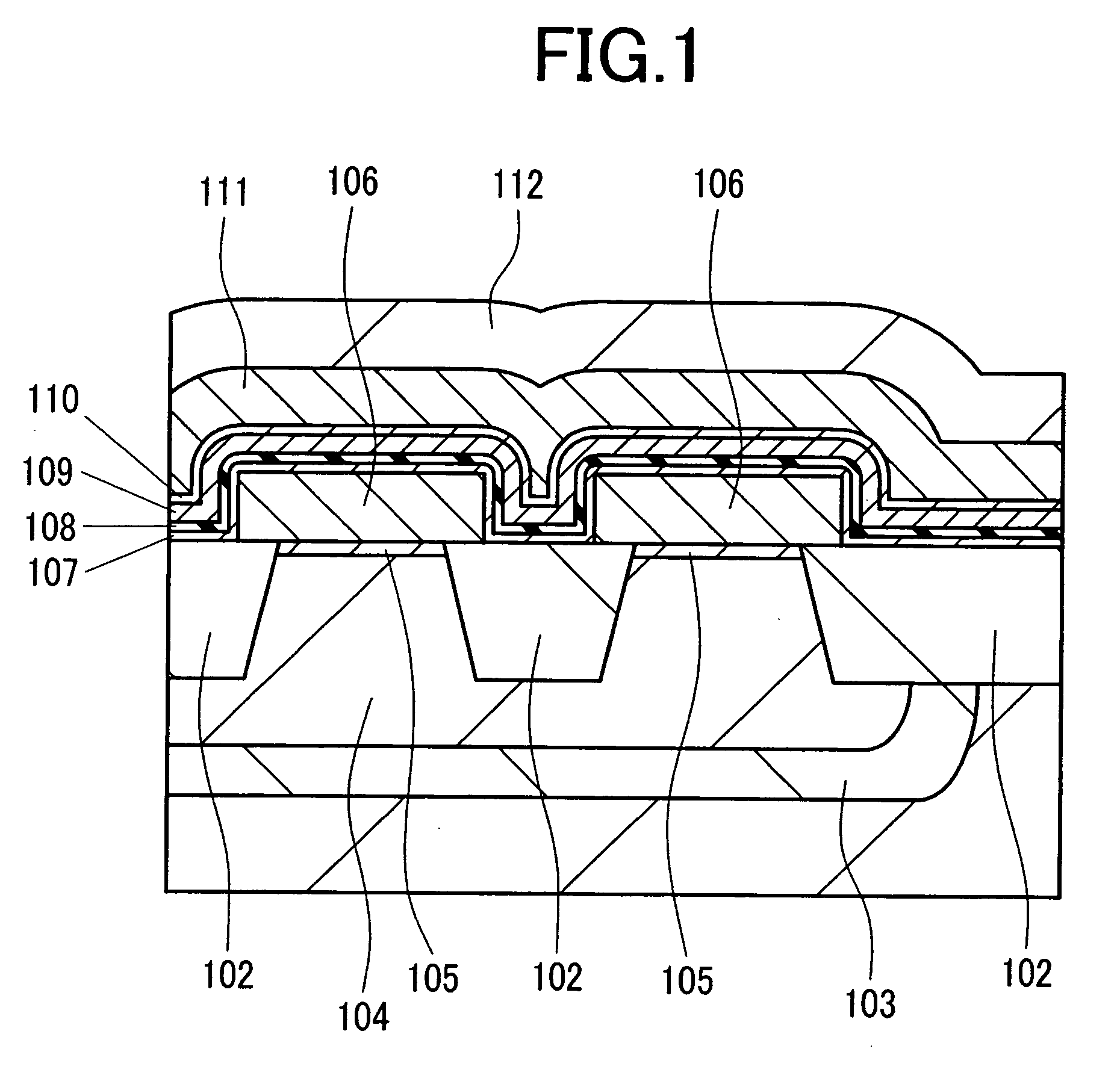Nonvolatile semiconductor storage and its manufacturing method
a manufacturing method and semiconductor technology, applied in semiconductor devices, electrical devices, transistors, etc., can solve problems such as process complexity and performance degradation, and achieve the effects of reducing power consumption, facilitating integration, and improving processing efficiency
- Summary
- Abstract
- Description
- Claims
- Application Information
AI Technical Summary
Benefits of technology
Problems solved by technology
Method used
Image
Examples
first embodiment
[0058] In this embodiment, an example is disclosed in which, by avoiding exposure of gate insulator films of transistors in a peripheral circuit and interfaces with silicon at the time of deposition of tantalum pentoxide of an ONTO structure and performing crystallization in a state where they were covered with poly silicon, a characteristic such as leakage current was improved at the standby time of the transistors in the peripheral circuit. This embodiment is the example where a memory cell configuration popularly called as an NOR type was adopted.
[0059] Main portions of manufacturing steps of a nonvolatile semiconductor memory device in this embodiment are shown in FIGS. 10A to 10F and FIGS. 11A to 11D. The nonvolatile semiconductor memory device is broadly classified into: [0060] (1) a memory array area in which memory cells are disposed in an array; and [0061] (2) a peripheral circuit area that functions to make memory cell selection and information reading and writing. The pe...
second embodiment
[0080] In this embodiment, other embodiment is disclosed in which by avoiding exposure of the gate insulator films of the transistors in the peripheral circuit and the interfaces with silicon at the time of deposition of the tantalum pentoxide film of the ONTO structure and performing crystallization in a state where they are covered with poly silicon, the characteristic such as leakage current at the standby time of the transistors in the peripheral circuit was improved. This embodiment is the example in which a memory cell configuration popularly called as an AND type was adopted.
[0081] Main portions of manufacturing steps of a nonvolatile semiconductor memory device in this embodiment are shown in FIGS. 12A to 12F and FIGS. 13A to 13F, and FIGS. 14A to 14D. As in the first embodiment, the memory array area, peripheral circuit area, high-voltage devices, and low voltage devices were displayed with the arrows on top. Further, as in the first embodiment, sections of the memory arra...
third embodiment
[0103] In this embodiment, other embodiment is disclosed in which by avoiding exposure of the gate insulator films of the transistors in the peripheral circuit and the interfaces with silicon at the time of deposition of tantalum pentoxide of the ONTO structure and performing crystallization in a state where they are covered with poly silicon, the characteristic such as leakage current at the standby time of the transistors in the peripheral circuit was improved. In this embodiment, third gates that are different from the floating gates and the control gates, (which will be hereinafter referred to as assist gates), are disposed in the memory array area, thereby separating the memory cells.
[0104] Main portions of manufacturing steps of a nonvolatile semiconductor memory device in this embodiment are shown in FIGS. 15A to 15F and FIGS. 16A to 16F, and FIGS. 17A to 17C. As in the first embodiment, the memory array area, peripheral circuit area, high voltage devices, and low voltage de...
PUM
| Property | Measurement | Unit |
|---|---|---|
| thickness | aaaaa | aaaaa |
| thickness | aaaaa | aaaaa |
| thickness | aaaaa | aaaaa |
Abstract
Description
Claims
Application Information
 Login to View More
Login to View More - R&D
- Intellectual Property
- Life Sciences
- Materials
- Tech Scout
- Unparalleled Data Quality
- Higher Quality Content
- 60% Fewer Hallucinations
Browse by: Latest US Patents, China's latest patents, Technical Efficacy Thesaurus, Application Domain, Technology Topic, Popular Technical Reports.
© 2025 PatSnap. All rights reserved.Legal|Privacy policy|Modern Slavery Act Transparency Statement|Sitemap|About US| Contact US: help@patsnap.com



